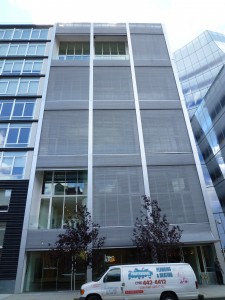Corbu in Chelsea
524 West 19th Street in New York’s Chelsea District is a small residential building designed by Shigeru Ban, with Dean Maltz. The 11-story block contains only 8 units which the developer calls “houses,” since they are two-story duplexes that extend through the building, front-to-back, recalling the units in Le Corbusier’s unité d’habitation in Marseilles. The Chelsea houses have two-story living rooms, too, and shallow loggias. There the resemblance ends, since these are expensive ($3.6 – $11.25 million) condominiums with Corian kitchen islands and Miele cook tops. Press a button and the entire motorized 20-foot glass wall,

